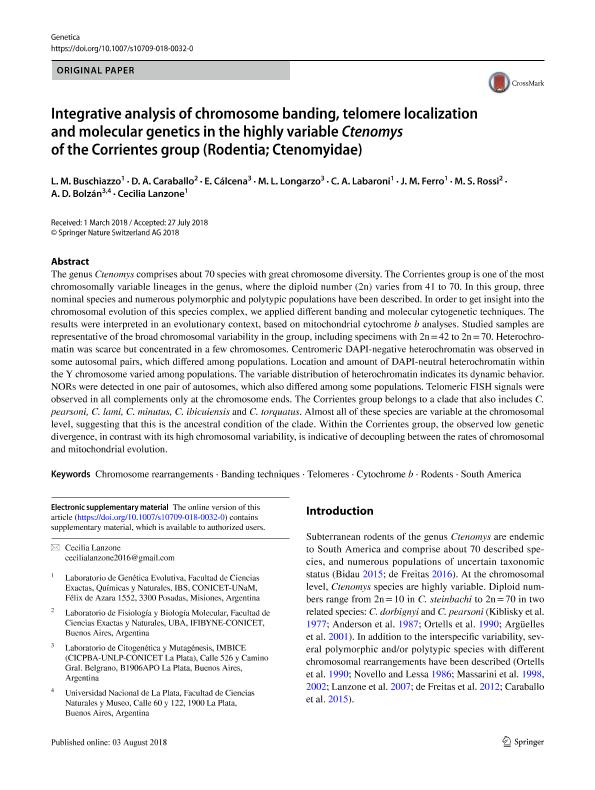Artículo
Integrative analysis of chromosome banding, telomere localization and molecular genetics in the highly variable Ctenomys of the Corrientes group (Rodentia; Ctenomyidae)
Buschiazzo, Leandro Maciel ; Caraballo, Diego Alfredo
; Caraballo, Diego Alfredo ; Cálcena, Eugenio Nicolás
; Cálcena, Eugenio Nicolás ; Longarzo, Maria Lucrecia
; Longarzo, Maria Lucrecia ; Labaroni, Carolina Alicia
; Labaroni, Carolina Alicia ; Ferro, Juan Martín
; Ferro, Juan Martín ; Rossi, Maria Susana
; Rossi, Maria Susana ; Bolzan, Alejandro Daniel
; Bolzan, Alejandro Daniel ; Lanzone, Cecilia
; Lanzone, Cecilia
 ; Caraballo, Diego Alfredo
; Caraballo, Diego Alfredo ; Cálcena, Eugenio Nicolás
; Cálcena, Eugenio Nicolás ; Longarzo, Maria Lucrecia
; Longarzo, Maria Lucrecia ; Labaroni, Carolina Alicia
; Labaroni, Carolina Alicia ; Ferro, Juan Martín
; Ferro, Juan Martín ; Rossi, Maria Susana
; Rossi, Maria Susana ; Bolzan, Alejandro Daniel
; Bolzan, Alejandro Daniel ; Lanzone, Cecilia
; Lanzone, Cecilia
Fecha de publicación:
10/2018
Editorial:
Springer
Revista:
Genetica
ISSN:
0016-6707
e-ISSN:
1573-6857
Idioma:
Inglés
Tipo de recurso:
Artículo publicado
Clasificación temática:
Resumen
The genus Ctenomys comprises about 70 species with great chromosome diversity. The Corrientes group is one of the most chromosomally variable lineages in the genus, where the diploid number (2n) varies from 41 to 70. In this group, three nominal species and numerous polymorphic and polytypic populations have been described. In order to get insight into the chromosomal evolution of this species complex, we applied different banding and molecular cytogenetic techniques. The results were interpreted in an evolutionary context, based on mitochondrial cytochrome b analyses. Studied samples are representative of the broad chromosomal variability in the group, including specimens with 2n = 42 to 2n = 70. Heterochromatin was scarce but concentrated in a few chromosomes. Centromeric DAPI-negative heterochromatin was observed in some autosomal pairs, which differed among populations. Location and amount of DAPI-neutral heterochromatin within the Y chromosome varied among populations. The variable distribution of heterochromatin indicates its dynamic behavior. NORs were detected in one pair of autosomes, which also differed among some populations. Telomeric FISH signals were observed in all complements only at the chromosome ends. The Corrientes group belongs to a clade that also includes C. pearsoni, C. lami, C. minutus, C. ibicuiensis and C. torquatus. Almost all of these species are variable at the chromosomal level, suggesting that this is the ancestral condition of the clade. Within the Corrientes group, the observed low genetic divergence, in contrast with its high chromosomal variability, is indicative of decoupling between the rates of chromosomal and mitochondrial evolution.
Archivos asociados
Licencia
Identificadores
Colecciones
Articulos(CCT - NORDESTE)
Articulos de CTRO.CIENTIFICO TECNOL.CONICET - NORDESTE
Articulos de CTRO.CIENTIFICO TECNOL.CONICET - NORDESTE
Articulos(IBS)
Articulos de INSTITUTO DE BIOLOGIA SUBTROPICAL
Articulos de INSTITUTO DE BIOLOGIA SUBTROPICAL
Articulos(IFIBYNE)
Articulos de INST.DE FISIOL., BIOL.MOLECULAR Y NEUROCIENCIAS
Articulos de INST.DE FISIOL., BIOL.MOLECULAR Y NEUROCIENCIAS
Articulos(IMBICE)
Articulos de INST.MULTIDISCIPL.DE BIOLOGIA CELULAR (I)
Articulos de INST.MULTIDISCIPL.DE BIOLOGIA CELULAR (I)
Citación
Buschiazzo, Leandro Maciel; Caraballo, Diego Alfredo; Cálcena, Eugenio Nicolás; Longarzo, Maria Lucrecia; Labaroni, Carolina Alicia; et al.; Integrative analysis of chromosome banding, telomere localization and molecular genetics in the highly variable Ctenomys of the Corrientes group (Rodentia; Ctenomyidae); Springer; Genetica; 146; 4-5; 10-2018; 403-414
Compartir
Altmétricas



